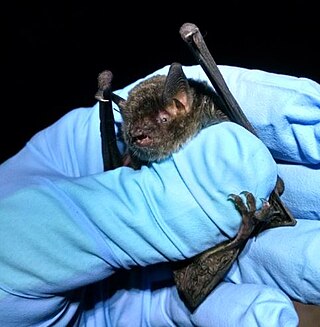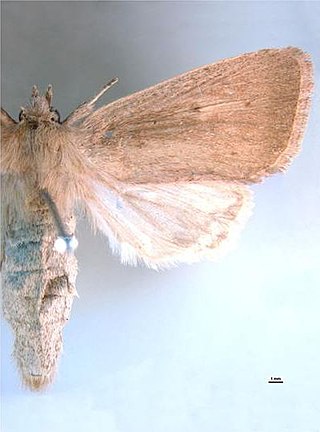
The gray bat is a species of microbat endemic to North America. It once flourished in caves all over the southeastern United States, but due to human disturbance, gray bat populations declined severely during the early and mid portion of the 20th century. 95% of gray bats now hibernate in only 15 caves. M. grisescens has been listed as federally endangered by the U.S. Fish and Wildlife Service since 1976, and is protected under the Endangered Species Act. Gray bat populations were estimated at approximately 2 million bats around the time they were placed on the Endangered Species list. By the early 1980s populations of gray bats dropped to 1.6 million. With conservation efforts in place, in 2004, gray bat populations were estimated to have reached 3.4 million.

Epipsilia grisescens is a moth of the family Noctuidae. It is found in Fennoscandia, Denmark as well as the Pyrenees, Alps, Apennines, Balkans and Carpathians. In the Alps it is found up to 2,000 meters.

Sesamia grisescens, the pink sugarcane borer, pink stalk borer, shoot borer, sugarcane borer or ramu shoot borer, is a moth of the family Noctuidae. The species was first described by Warren in 1911. It is found in Papua New Guinea, Seram, the Moluccas and New Britain.
Dystasia is a genus of longhorn beetles of the subfamily Lamiinae, containing the following species:
Dystasia javanica is a species of beetle in the family Cerambycidae. It was described by Stephan von Breuning in 1938.
Dystasia proxima is a species of beetle in the family Cerambycidae. It was described by Stephan von Breuning in 1938. It is known from Borneo.
Dystasia siamensis is a species of beetle in the family Cerambycidae. It was described by Stephan von Breuning in 1938.
Dystasia subcristata is a species of beetle in the family Cerambycidae. It was described by Stephan von Breuning in 1938.
Dystasia bella is a species of beetle in the family Cerambycidae. It was described by Stephan von Breuning in 1940.
Dystasia chassoti is a species of beetle in the family Cerambycidae. It was described by Stephan von Breuning in 1973.
Dystasia humeralis is a species of beetle in the family Cerambycidae. It was described by Stephan von Breuning in 1958.
Dystasia laterivitta is a species of beetle in the family Cerambycidae. It was described by Stephan von Breuning in 1942.
Dystasia valida is a species of beetle in the family Cerambycidae. It was described by Stephan von Breuning in 1937. It is known from Borneo.
Dystasia semicana is a species of beetle in the family Cerambycidae. It was described by Francis Polkinghorne Pascoe in 1864.
Dystasia nubila is a species of beetle in the family Cerambycidae. It was described by Francis Polkinghorne Pascoe in 1886. It is known from Sumatra and Borneo.
Dystasia cristata is a species of beetle in the family Cerambycidae. It was described by Warren Samuel Fisher in 1933.
Dystasia sibuyana is a species of beetle in the family Cerambycidae. It was described by Per Olof Christopher Aurivillius in 1927. It is known from Malaysia, the Philippines and Borneo.
Dystasia similis is a species of beetle in the family Cerambycidae. It was described by Charles Joseph Gahan in 1907.
Dystasia tonkinea is a species of beetle in the family Cerambycidae. It was described by Maurice Pic in 1930.
Dystasia variegata is a species of beetle in the family Cerambycidae. It was described by Warren Samuel Fisher in 1936.


